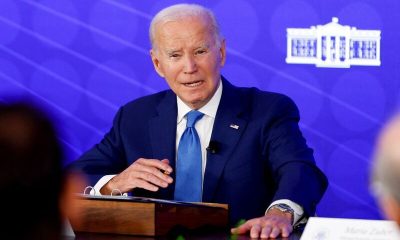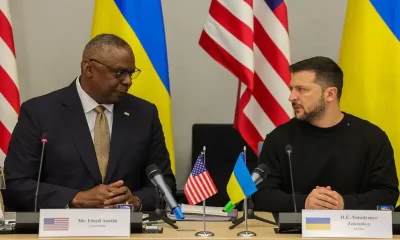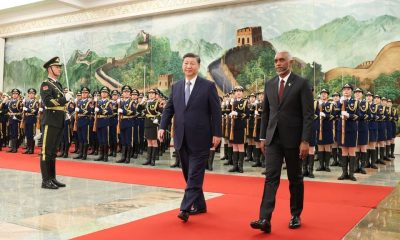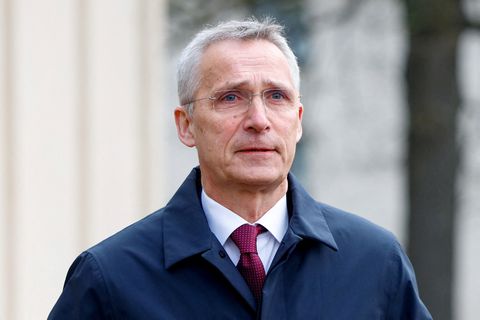ECONOMY
Belgium wants sanctions against Israel for Gaza bombings – Deputy PM.
In a televised briefing on Wednesday, Israel’s military spokesperson, Rear Admiral Daniel Hagari, stated that Hamas had lost control of the northern part of Gaza as thousands of inhabitants have gone south.
“50,000 Gazans moved from the northern to the southern parts of the Gaza Strip. Rear Admiral Daniel Hagari stated, “They are moving because they recognize that Hamas has lost power in the north.” “Hamas has lost control and is continuing to lose control in the north.”
Following a Hamas incursion on southern Israel on October 7, during which militants murdered 1,400 people—mostly civilians—and captured over 240 prisoners, according to Israeli accounts, Israel launched an attack on Gaza. The deadliest phase of the long-running Israel-Palestinian conflict has broken out in this war.
De Sutter stated that to improve political and economic relations, the European Union should immediately revoke its association agreement with Israel.
She said that the EU should forbid the entry of aggressive settlers, politicians, and troops guilty of war crimes, as well as impose an import embargo on goods from occupied Palestinian territory.
She also suggested that Belgium cut all financial support to Hamas while simultaneously increasing financing for the International Criminal Court in The Hague to look into the bombings.
“This group supports terrorism.” Sanctions on the businesses and individuals that give money to Hamas are necessary since terror costs money, according to De Sutter. UN representatives and the G7 countries increased their calls for a humanitarian ceasefire in the fighting as the conflict moves into its second month, hoping to lessen the suffering of those left in Gaza, where basic supplies are running low and houses have been destroyed.
More than 10,000 people have reportedly died, 40% of whom were youngsters, according to Palestinian officials.
ECONOMY
U.S. strike kills militia leader blamed for Iraq attacks, – U.S. official
A U.S. strike kills a militia leader blamed for Iraq attacks, according to a U.S. official. According to a U.S. official who spoke to Reuters, the U.S. military killed a militia commander in a retaliatory strike on Thursday in Baghdad, which it claims is responsible for recent attacks on U.S. forces.
A drone fired at least two missiles into an al-Nujaba’a militia base in eastern Baghdad, according to witnesses and sources with the Iraqi police.
According to police and militia sources, the rockets killed four people, including a local group leader and one of his assistants. The rockets struck a car within the Nujaba’a headquarters. Health sources confirmed the death toll.
Since the Israel-Hamas battle started in October, the U.S. military has been attacked in Iraq and Syria at least 100 times, most often by a combination of missiles and uncrewed aerial vehicles.
900 US soldiers are stationed in neighboring Syria and 2,500 in Iraq to stop Islamic State extremists from rising again.
The military spokesperson for the prime minister stated, “The Iraqi armed forces hold the international coalition forces responsible for this unjustified attack on an Iraqi security entity.” He was alluding to Thursday’s strike.
The statement identified the paramilitary organization as an Iraqi force acting with Prime Minister Mohammed Shia al-Sudani’s authorization. According to the U.S. official, the strike was carried out to kill the militia commander when it struck the vehicle.
Videos of a burned-out car were posted on websites that supported the military. Reuters could not independently confirm the validity of the video.
Groups in Syria and Iraq that support Iran reject Israel’s Gaza campaign and blame the U.S. in part for it. A year ago, Prime Minister Al-Sudani required the assistance of some factions sponsored by Iran to obtain office; these factions now represent a significant bloc in his ruling coalition, over which he has limited influence.
According to Iraqi security officials, a government investigation is ongoing, and they stated they had no more information about who may have carried out the strike.
Commanders of the Iraqi militias declared they would respond against the United States for allegedly orchestrating the strike.
“We intend to strike back and cause the Americans to regret launching this aggression,” a local leader of the Iraqi militia, Abu Aqeel al-Moussawi, declared. The U.S. launched counterattacks in Iraq last month in response to a drone strike by insurgents affiliated with Iran that left one U.S. serviceman critically injured and two others wounded.
ECONOMY
Finland will sign a defense pact with the US.
On Monday, December 18, Finland and the United States will sign a defense cooperation agreement, according to a statement the Finnish government issued on Thursday. This deal would provide the United States military extensive access throughout the Nordic nation to the region of its long border with Russia through Finland.
This year, in reaction to Russia’s invasion of Ukraine in 2022, Finland, which is located in the Nordic region and is Russia’s neighbor, became the newest member of the North Atlantic Treaty Organization (NATO).
The fact that there will be no need to agree on everything individually makes it easier to organize activities during times of peace. However, Elina Valtonen, Finland’s Minister of Foreign Affairs, told the media that it might be even more crucial in times of crisis.
According to statements made by authorities before the announcement, the agreement with the United States is to facilitate the arrival of military assistance and assistance to Finland in the event of a conflict.
Under the terms of the deal, the United States military will have unrestricted access to fifteen different locations and regions in Finland, where it could also keep military vehicles, ammunition, and other supplies.
According to the deal, the regions would have four airbases, a military port, and railway access to northern Finland. In addition, the United States military will have a storage space adjacent to a railway that runs up to the Russian border.
Reuters reported in July that Finland is working to improve its railway infrastructure on its Swedish border. The goal of this improvement is to make it simpler for allies to send reinforcements and equipment from across the Atlantic to Kemijarvi, which is located an hour’s drive from the Russian border and seven hours from Russia’s nuclear bastion and military bases near Murmansk in the Kola peninsula.
Last week, Sweden inked a similar arrangement with the United States, which granted it access to 17 places, including four air bases, one harbor, and five military camps. Sweden has also requested membership in NATO, but it has been left waiting owing to reluctance from current members Turkey and Hungary.
The United States of America has signed similar agreements with several other NATO countries, including Norway, Bulgaria, Latvia, Lithuania, Poland, Slovakia, the Czech Republic, Hungary, and Estonia. The deal with Denmark is now awaiting ratification.
Government authorities have said that Finland would not permit the storage or transportation of nuclear and biological weapons, as well as anti-personnel mines, on its territory. This decision is based on the international non-proliferation treaties that Finland has already agreed to.
According to them, there are no plans to establish permanent bases in Finland, but the United States military can maintain a permanent presence and conduct regular exercises there.
Monday will be the day the deal is signed in Washington, District of Columbia, before legislators in both nations.
ECONOMY
Nations strike a deal at COP28 to transition away from fossil fuels.
At the COP28 climate conference, which took place on Wednesday, representatives from almost 200 nations reached an agreement to begin lowering the global use of fossil fuels to prevent the most severe effects of climate change. This agreement was reached, which signals the ultimate end of the oil era.
After two weeks of intense discussions, the agreement reached in Dubai was intended to send a strong message to investors and policymakers that the globe is unified in its goal to break with fossil fuels. According to scientists, this is the last best option to prevent a global disaster from occurring.
The accord was described as “historic” by the President of COP28, Sultan al-Jaber, but he stressed that the deal’s success will be determined by how well it is implemented.
He told the full plenary at the summit, “We are what we do, not what we say,” adding that we are what we do. “We must take the steps necessary to turn this agreement into tangible action.”
Several nations praised the pact since it successfully achieved something outside the scope of climate discussions for decades.
In a statement, Norway’s Minister of Foreign Affairs, Espen Barth Eide, stated, “It is the first time that the world unites around such a clear text on the necessity of transitioning away from fossil fuels.”
Over one hundred nations exerted great effort to include strong wording in the COP28 agreement that would “phase out” the use of oil, gas, and coal. The oil producer organization OPEC, which Saudi Arabia chairs, vehemently opposed them. OPEC stated that the world can reduce emissions without avoiding certain fuels.
Some observers were concerned that the discussions might come to a standstill due to this conflict, which caused the summit to run into overtime for a whole day on Wednesday.
The countries’ governments that are members of the Organization of the Petroleum Exporting Countries primarily depend on the money generated from the oil industry. These countries hold almost 80 percent of the world’s proven oil reserves and around one-third of the world’s oil production.
On the other hand, small climate-vulnerable island states were among the most outspoken advocates of phasing out fossil fuels. They had the support of major oil and gas producers such as the United States of America, Canada, and Norway, as well as the European Union and many other governments.
“This is a moment where multilateralism has actually come together and people have taken individual interests and attempted to define the common good,” said John Kerry, the United States climate envoy, after the agreement was approved.
As the principal negotiator for the Alliance of Small Island States, Anne Rasmussen expressed her disapproval of the accord, stating that it lacked ambition.
“We have made an incremental advancement over business as usual, when what we really need is an exponential step change in our actions,” stated the spokesperson.
However, she did not give a formal objection to the agreement, and the audience responded to her remarks with a standing ovation that lasted for about two minutes.
Dan Jorgensen, the Danish Minister for Climate and Energy, expressed his astonishment at the circumstances surrounding the pact, stating, “We are standing here in an oil country, surrounded by oil countries, and we made the decision saying let’s move away from oil and gas.”
The proposed agreement aims to ” transition away from fossil fuels in energy systems in a just, orderly, and equitable manner… to achieve net zero by 2050 in keeping with the science.”
This terminology, to a certain degree, depicts what has already started to take place, with an increasing number of countries establishing laws in recent years to transition to a more environmentally friendly economy.
Europe and the United States have phased out their fleets of coal-fired power plants; the installation of renewable power capacity throughout the globe has reached record levels; and several nations have enacted measures to support the commercialization of electric cars.
The agreement requires countries to speed up this process, notably by tripling the capacity of renewable energy producers throughout the world by the year 2030, boosting efforts to limit the amount of coal used, and speeding up the development of technology such as carbon capture and storage that help clean up industries that are difficult to decarbonize.
The deal was described as “a menu where every country can follow its own pathway,” according to a source familiar with Saudi Arabia’s position. The source also stated that the deal “shows the various tracks that will allow us to maintain the objective of 1.5 (degrees Celsius) in accordance with the characteristics of every nation and in the context of sustainable development.”
Several other oil-producing nations, notably the United Arab Emirates, which hosted the conference, had campaigned to include carbon capture in the agreement. It is possible to exploit the technology to justify continuing to drill, according to critics, who claim that it is still costly and has not been demonstrated to work at scale.
In addition, former Vice President Al Gore expressed his approval of the accord. However, he also stated: “The influence of petrostates is still evident in the half measures and loopholes included in the final agreement.”
Now that the agreement has been reached, the nations must deliver through their national policies and investments.
The nation of China, which is now the largest carbon polluter in the world, has proposed that industrialized nations should take the initiative.
According to Zhao Yingmin, the vice environment minister of the nation, “Developed countries have unshirkable historical responsibilities for climate change.” This statement was made after the treaty was adopted.
Climate-conscious governments in the United States, the world’s leading producer of oil and gas and the most significant historical emitter of greenhouse gases, have had difficulty passing laws that align with their climate commitments through a split Congress.
Last year, Vice President Joe Biden of the United States of America achieved a significant win by securing the approval of the Inflation Reduction Act, which included subsidies for renewable energy that totaled hundreds of billions of dollars.
Over the past several years, there has been growing public support for renewable energy and electric cars from Brussels to Beijing. This support, together with advancements in technology, falling prices, and more private investment, has also contributed to the fast rise of applications for these technologies.
Despite this, oil, gas, and coal are responsible for around 80 percent of the world’s energy supply, and there is a broad range of forecasts regarding when the global demand will ultimately reach its peak.
Rachel Cleetus, the policy director of the Union of Concerned Scientists, expressed her admiration for the climate pact; nevertheless, she stated that it does not commit wealthy nations to provide more funding to assist developing nations in paying for the transition away from fossil fuels.
“The finance and equity provisions… are seriously insufficient and must be improved in the time ahead in order to ensure low- and middle-income countries can transition to clean energy and close the energy poverty gap,” said the representative.
-

 Geopolitics & Foreign Policy2 months ago
Geopolitics & Foreign Policy2 months agoTurkey’s Erdogan says he may visit Egypt soon, discuss Gaza patients -media.
-

 Europe3 months ago
Europe3 months agoRussia’s Shoigu accuses the West of seeking to expand the Ukraine war to the Asia-Pacific.
-

 Geopolitics & Foreign Policy2 months ago
Geopolitics & Foreign Policy2 months agoCeasefire takes hold in Gaza ahead of hostage release; aid enters enclave.
-

 Geopolitics & Foreign Policy2 months ago
Geopolitics & Foreign Policy2 months agoRussia deploys new nuclear missile in Kaluga region – RIA
-

 America4 months ago
America4 months agoRepublican US House to hold first Biden impeachment inquiry hearing
-

 Geopolitics & Foreign Policy2 months ago
Geopolitics & Foreign Policy2 months agoChina’s military: US Navy ship ‘illegally’ entered territorial waters
-

 Europe4 months ago
Europe4 months agoZelenskiy, at NATO HQ, asks for weapons to face winter of ‘terror’
-

 Agriculture5 months ago
Agriculture5 months agoIAEA, Japan agree on continuous safety review of Fukushima water














